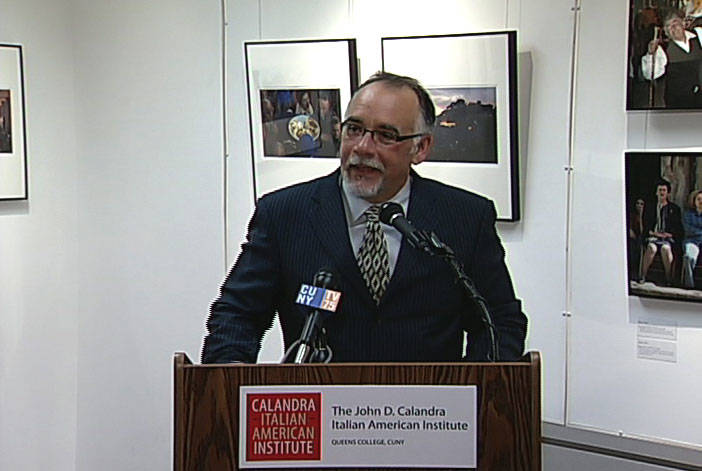Fred Gardaphe: The Importance of Defining “Identity”
Last Thursday marked the start of “Italians in the Americas,” a three-day conference hosted by the John D. Calandra Italian/American Institute (Queens College, CUNY). The papers and presentations were devoted to analyzing the diverse and varied aspects of “italianità” in the Americas, with significant contributions from scholars from North and South America as well as from Italy.
After a brief introduction by Anthony J. Tamburri, Dean of the Institute, and a welcome by James Muyskens, President of Queens College, Fred Gardaphe, who was recently appointed Distinguished Professor of Italian Studies at the Calandra Institute, delivered the keynote lecture entitled “Beyond the Immigrant Paradigm: Identities and the Future of Italian American Culture.”
Gardaphe’s address focused on the idea of identity within the past and future of Italian communities in the United States. Beginning with the famous concept of a “melting pot,” Gardaphé explained that in reality it refers only to a myth. Through a fascinating historical account, he demonstrated how the fifth largest ethnic group in the U.S. has had to revisit its concept of identity, reconstructing and reinventing it with each new generation. Italians in America “had to constantly renegotiate the relationship between their local culture and their origins.” This reconstruction of identity is carried out not only with great respect for the past, but also with great attention to evolution and future change. The various Little Italies still remain relevant and important places where Italian culture and customs are handed down through generations without the aid of books or organized activities. Little Italies, however, are disappearing and as a result, cultural knowledge and the reinvention of Italian identity in America is a process that must be transformed to include ongoing and coordinated intellectual activity.
Through a series of entertaining but crude anecdotes, Gardaphe tackled the theme of assimilation into American society. Many stories illustrate this struggle, especially the internal struggle to reconcile one’s origins with the dominant culture of the host country. The assimilation process sometimes included the necessity of “Americanizing” one’s Italian surname and frequently included changing minute aspects of one’s everyday life, but it was these seemingly small changes which amounted to significant steps in bridging the gap with the new culture. Gardaphe showed that within the context of history, Italian/American identity is fluid and not at all static or frozen in time, despite how it may appear to those who are not directly involved in this work. Italian/American identity is in constant transformation and it is poised for another step towards self-realization. According to the Census Bureau, there has been an exponential increase in persons who choose to identify themselves as being of Italian decent. If one reads this data in light of the decrease in Italian migration, it is further evidence that the question of identity is much less rigid than one would tend to believe.
One of the crucial points of the lecture is the importance of defining “identity.” According to Gardaphe, the act of defining, individualizing, and investigating one’s own identity is in fact the only way to escape from the “interpretive cage” constructed by those outside of the Italian/American community. This cage has been created from a series of stereotypes and common associations that are connected mostly to the world of organized crime, but also to food, and convey a series of negative interpretations and a pejorative and simplistic view of Italian culture. It is therefore a cultural imperative for the community to examine and define itself rather than continue to be defined by others.
For Gardaphe, the primary way to resolve this question is by introducing it into a larger discussion of race. The meeting of the Italian and American cultures resulted in the community’s transformation and the reshaping of its relationship with its own roots. The process became stronger as the Italian “race” was increasingly considered an integrated part of the white race. This peculiar status required the community to assimilate with respect to different behaviors, mental attitudes, and ways of relating to other ethnic groups as well as the dominant culture. In the long run, undergoing a metamorphosis of this type cannot but leave indelible marks on the concept of a collective identity.
In conclusion, it is important that in the future the subject of the Italian/American community’s identity will be considered by those within cultural and educational institutions. In this way, ideas will begin to circulate and they will eventually go beyond the geographical space limited to and represented by the various “Little Italies.”
The transmission of the Italian/American culture in the past has been based on oral tradition rather than a literary one. It is necessary for our cultural survival that we succeed in renegotiating our own identity through a careful study of ourselves. Italian Americans must therefore examine “both history and story.” If they do not, the subject of Italian/American identity will continue to be determined by “others.”
(Translated by Giulia Prestia)


































i-Italy
Facebook
Google+
This work may not be reproduced, in whole or in part, without prior written permission.
Questo lavoro non può essere riprodotto, in tutto o in parte, senza permesso scritto.